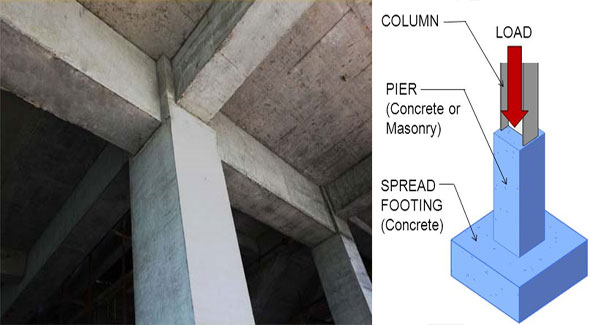How to Calculate the Load on a Column
- Concrete Cost Estimator
- Concrete Continuous Footing
- Landscape Bidding and Estimating
- Construction Cost Estimating
- Concrete and steel cost estimation
- Construction Cost Estimate Breakdown
- Construction Estimating Worksheet
- Home Construction Cost Estimate
- Estimate Pricing Sheet
- Sheet for General Contractor
- Construction Cost Estimate
- Labor Materials Cost Estimator
- Masonry Estimating Sheet
- Sheet for Building Contractor
- Construction Schedule Bar chart
- General Cost Estimator Sheet
- General Construction Estimate
- Building and Road Estimating Sheet
- Detailed expense estimates
- Door and Window Takeoff Sheet
- General Construction Cost Estimating Sheet

In this civil engineering article, you will get some useful notes on how to work out the loads for column and footings in a structure.
Sorts of loads on column:
1. Self weight of the column x Number of floors
2. Self weight of beams per running meter
3. Load of walls per running meter
4. Total Load of slab (Dead load + Live load + Self weight)
The columns are also susceptible to bending moments which should be included in the final design. To accelerate the design process, utilize advanced structural design software like ETABS or STAAD Pro.
The structural loading calculations are performed based on the following fundamental assumptions :-
For Columns: Self weight of Concrete is approx 2400 kg per cubic meter that is identical to 240 kN. Self weight of Steel is approx 8000 kg per cubic meter.
In case of a large column size of 230 mm x 600 mm containing 1% steel and 3 meters standard height, the self weight of column should be approx 1000 kg per floor, that is identical to 10 kN. Therefore, here, self weight of column is taken among 10 to 15 kN per floor.
For Beams: Suppose, each meter of beam contains dimensions of 230 mm x 450 mm exclusive of slab thickness. Therefore, the self weight remains approx 2.5 kN per running meter.
Also Read: Tips to work out the total loads on a column and related footing
For Walls: Density of bricks differs among 1500 to 2000 kg per cubic meter. For a 6″ thick wall with 3 meter height and 1 meter length, the load per running meter will be computed as identical to 0.150 x 1 x 3 x 2000 = 900 kg that is same as 9 kN/meter. This method is also applicable for working out the load per running meter for different types of bricks.
For autoclaved, aerated concrete blocks similar to Aerocon or Siporex, the weight per cubic meter remains among 550 to 700 kg per cubic meter. If these types of blocks are used for construction, the wall loads per running meter become as low as 4 kN/meter, which can lead to a major cutback in the construction cost.
For Slab: Suppose, the thickness of the slab remains 125 mm. Now each square meter of slab would contain a self weight of 0.125 x 1 x 2400 = 300 kg which is identical to 3 kN. Now, guess Finishing load to be 1 kN per meter and superimposed live load to be 2 kN per meter. Therefore, the slab load will be calculated around 6 to 7 kN per square meter.
Factor of Safety: In the end, once the total load on a column is compute, never forget to add in the factor of safety. For IS 456:2000, the factor of safety is 1.5.

- Application of concrete calculator
- Roofing Calculator can streamline the roof estimating process
- House construction cost calculator
- Engineering column design excel spreadsheet
- Material Estimating Sheet with Excel
- Materials List and Cost Estimate Worksheet
- Concrete Slab Estimating Calculator Sheet
- Common types of foundations for buildings
- Online calculation of construction materials
- Estimating with Excel for the Small Contractor
- Concrete Beam Design Spreadsheet
- Virtual Construction Management app for construction
- Autodesk’s Project Skyscraper
- Reed Construction’s Reed Insight
- Manage your construction project documentation
- Costimator, the popular cost estimating software
- On Center Software for construction professionals
- Free Construction Estimating Software
- Plumbing Calc Pro
- Cost Estimate Worksheet
- HVAC Piping Quantity Takeoff Worksheet
- Construction Estimating Software Sheet
- Estimate Cost Templates
- Construction Punch List
- Construction cost estimating template consisting estimating basic
- Gantt Chart Template for Excel
- Download Civil Engineering Spreadsheets with Verification
- The Building Advisor Estimating and Budgeting Worksheet
- Spreadsheet for design of concrete bridge
- Construction Estimating Software Free








